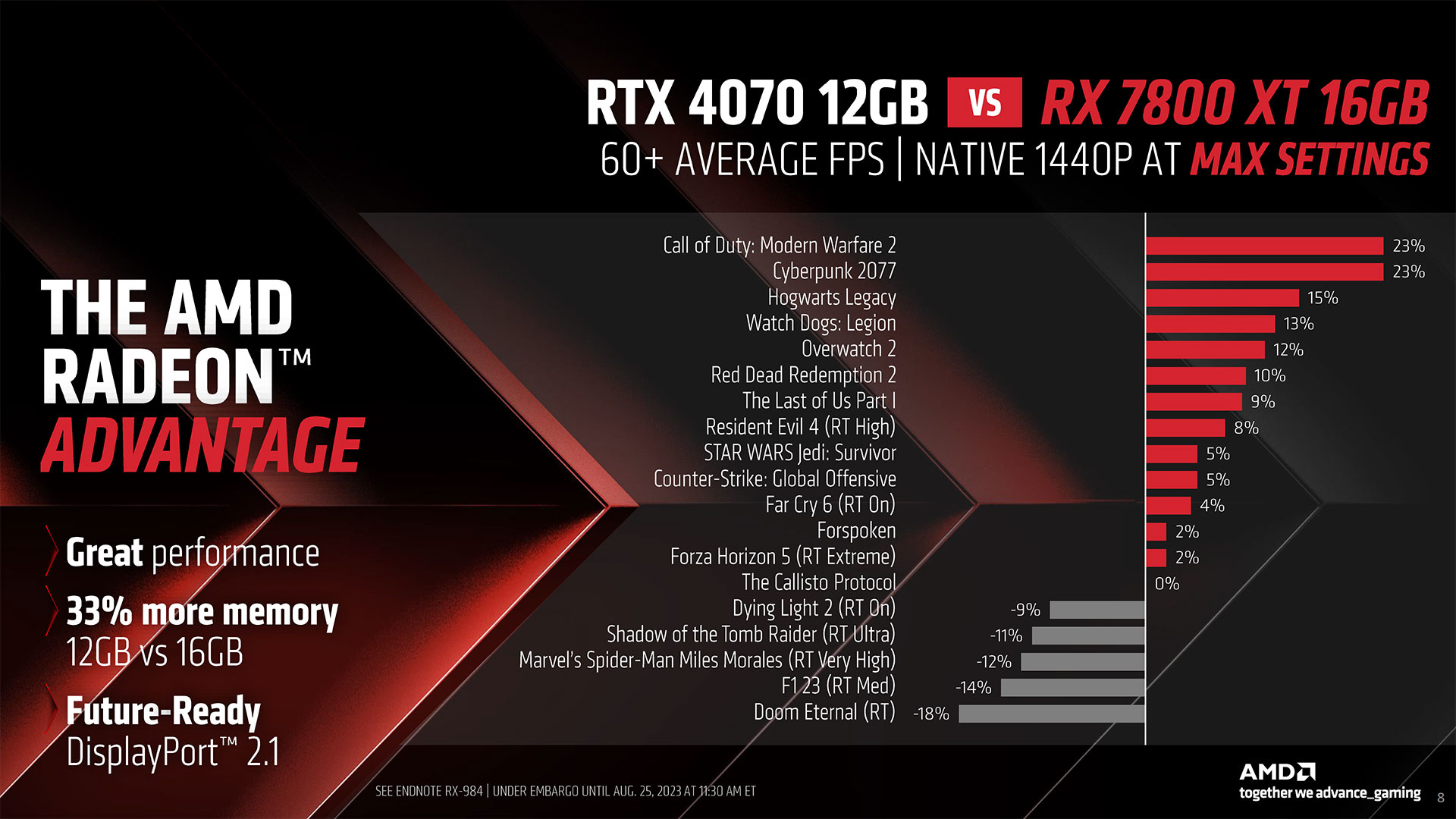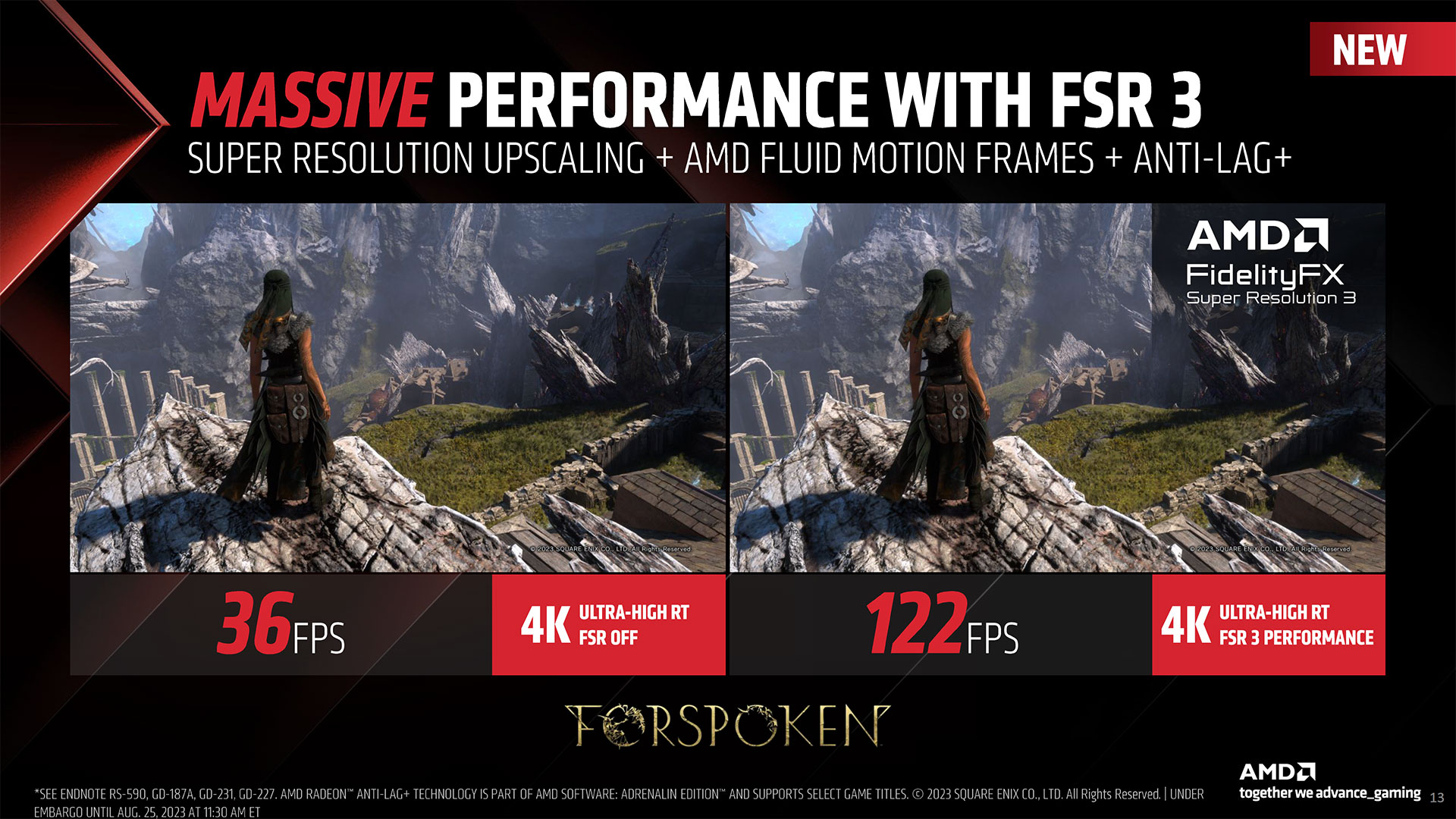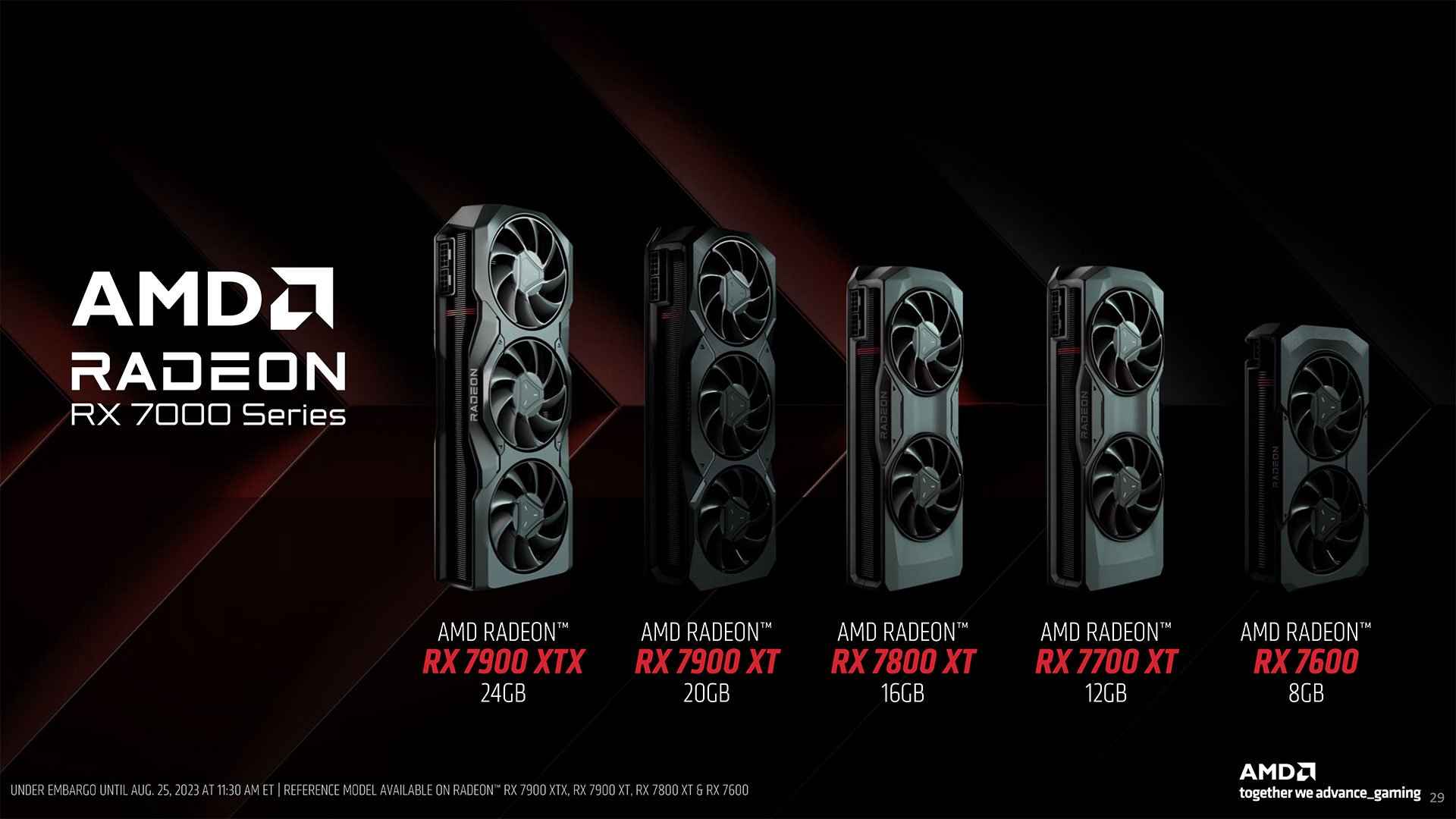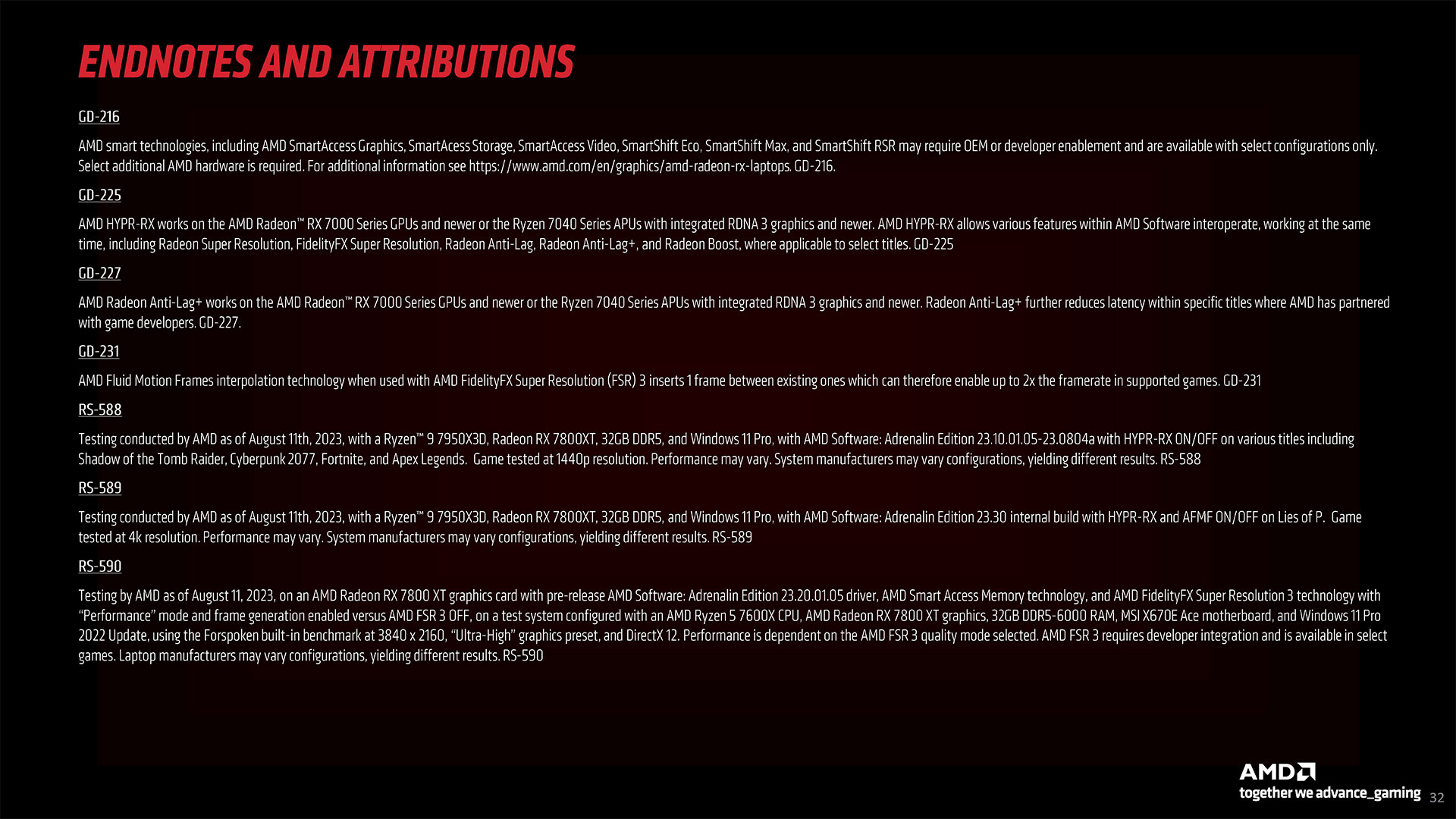AMD Announces Radeon RX 7800 XT at $499, RX 7700 XT at $449
Navi 32 officially arrives on September 6, 2023.

AMD launched its RDNA 3 architecture and RX 7000-series GPUs last December. It followed the top-tier Navi 31 by skipping the middle ground and releasing the budget-mainstream RX 7600 with the Navi 33 GPU. Now it's finally time to fill in the gap with the announcement of Navi 32 and the Radeon RX 7800 XT and Radeon RX 7700 XT. They're set to compete with the best graphics cards when they arrive on September 6, 2023.
As usual, the existence of and pending launch of these new GPUs has been about as secret as the color of the sky. The first rumblings of the basic specs for the RDNA 3 GPU lineup appeared last September. Yes, one year before the Navi 32 announcement, we had an estimated die size of 200 mm^2 for the GCD (Graphics Compute Die), with it linked to three or four MCDs (Memory Cache Dies). While we don't have an official die size just yet, we do have all of the other details. Let's go ahead and start with the specs table, comparing the new GPUs to the previous generation.
| Graphics Card | RX 7800 XT | RX 7700 XT | RX 6800 XT | RX 6700 XT |
|---|---|---|---|---|
| Architecture | Navi 32 | Navi 32 | Navi 21 | Navi 22 |
| Process Technology | TSMC N5 + N6 | TSMC N5 + N6 | TSMC N7 | TSMC N7 |
| Transistors (Billion) | ? + 4x 2.05 | ? + 3x 2.05 | 26.8 | 17.2 |
| Die size (mm^2) | 200? + 150 | 200? + 113 | 519 | 336 |
| Compute Units | 60 | 54 | 72 | 40 |
| GPU Cores (Shaders) | 3840 | 3456 | 4608 | 2560 |
| AI Cores | 120 | 108 | N/A | N/A |
| RT Accelerators | 60 | 54 | 72 | 40 |
| Boost Clock (MHz) | 2430 | 2544 | 2250 | 2581 |
| VRAM Speed (Gbps) | 19.5 | 18 | 16 | 16 |
| VRAM (GB) | 16 | 12 | 16 | 12 |
| VRAM Bus Width | 256 | 192 | 256 | 192 |
| Infinity Cache | 64 | 48 | 128 | 96 |
| ROPs | 128? | 96? | 128 | 64 |
| TMUs | 240 | 216 | 288 | 160 |
| TFLOPS FP32 (Boost) | 37.3 | 35.2 | 20.7 | 13.2 |
| TFLOPS FP16 (Boost) | 74.6 | 70.4 | 41.4 | 26.4 |
| Bandwidth (GBps) | 624 | 432 | 512 | 384 |
| TDP (watts) | 263 | 245 | 300 | 230 |
| Launch Date | Sept 6, 2023 | Sept 6, 2023 | Nov 18, 2020 | Mar 18, 2021 |
| Launch Price | $499 | $449 | $649 | $479 |
| Online Price | N/A | N/A | $520 | $320 |
The Navi 32 story and the RX 7800 XT and RX 7700 XT are basically as expected. While the GPU shader counts are theoretically lower than before, keep in mind that each shader is now able to do twice as many FP32 (or FP16) operations per clock, which results in a substantial boost to theoretical performance. The RX 7800 XT has 37 teraflops of graphics compute, 80% more than the previous generation RX 6800 XT. Similarly, the RX 7700 XT offers 35 teraflops of FP32 compute, an even larger 167% increase over the RX 6700 XT.
It's an interesting mishmash of specifications, in other words. Both new cards use the same Navi 32 GCD, which has up to 60 Compute Units (CUs) and four MCD links available. The 7800 XT uses the full die and all four MCDs, while the 7700 XT disables six of the CUs and one of the MCDs.
Raw memory bandwidth improves slightly, gen over gen, thanks to higher VRAM clocks. The 7800 XT has 22% more bandwidth than the 6800 XT, and the 7700 XT offers 12.5% more bandwidth than the 6700 XT (and the same bandwidth as the 6750 XT). However, it's important to note that the Infinity Cache sizes are quite a bit smaller, which means the effective bandwidth might not actually be better and could potentially be worse. Also, putting the L3 cache on separate chips linked via an Infinity Fabric introduces some additional latency.
If you just look at the specs, the improvements look quite good, maybe even great. However, as we've seen with the other RDNA 3 GPUs, specifications aren't everything. The RX 7600 as an example offers twice the compute performance of the RX 6650 XT in theory; in practice, gaming performance has changed very little. Similarly, RX 7900 XTX offers 159% more compute than RX 6950 XT, but real-world performance only shows up to a 40% improvement — that's at 4K, with a 30% increase at 1440p. If that pattern holds, the RX 7800 XT will probably land somewhere around the existing RX 6900 XT level, and the RX 7700 XT will likely fall closer to the RX 6800.




We don't just have to guess at performance, either. AMD provided some internal benchmarks comparing the two upcoming GPUs with some existing Nvidia parts. And unlike Nvidia, AMD isn't being delusional and suggesting that $400 to $500 cards are "designed for 1080p" so all of their benchmarks are at 1440p. The usual caveats apply, naturally, but we have our own benchmarks of the Nvidia cards and previous generation AMD cards, so we can at least make some comparisons on some of the games.
For example, in Red Dead Redemption 2, the RX 6900 XT in our testing is 8% faster than the RTX 4070 at 1440p and max settings. Likewise, the RX 6800 in our testing is 18% faster than the RTX 4060 Ti (8GB). In Watch Dogs Legion, the 6900 XT beats the RTX 4070 by 18% and the RX 6800 beats the RTX 4060 Ti by 23%. So far, the 7800 XT and 7700 XT look like near-perfect stand-ins for the previous generation GPUs.
We have two more games where our testing at least overlaps AMD's, at least in name (we don't have precise details on the settings and test sequences AMD uses, so our results may not be 100% comparable). Forza Horizon 5 has the 7800 XT leading the RTX 4070 by just 2%, and the same 2% applies to the 7700 XT and 4060 Ti. In our testing, without ray tracing (because it's not in the main game, unless things have changed), the 6900 XT is 10% faster than the RTX 4070 and the RX 6800 beats the 4060 Ti by 16%.
And last but not least, for Spider-Man: Miles Morales (this time with RT set to very high), AMD puts the 7800 XT 12% behind the 4070 and the 7700 XT is tied with the 4060 Ti. Our testing has the 6900 XT trailing the 4070 by 13%, while the RX 6800 ends up 1% ahead of the RTX 4060 Ti.
Given what we've seen so far, then, it's a reasonably safe bet that the new RX 7800 XT will come very close to matching the previous gen RX 6900 XT, and the new RX 7700 XT will come very close to matching the RX 6800. Maybe things will swing 5 to 10 percent or so in either direction, depending on the game. But overall, that's how the new and previous-gen GPUs appear to match up.






It's not just about performance, naturally, as the new RDNA 3 architecture adds a lot of other features. It has improved video encoding/decoding support with AV1 support — not drastically improved quality based on our previous testing, but at least for AV1 and HEVC it's pretty good. You also get DisplayPort 2.1 UHB13.5 support (54 Gbps) video outputs, in case you want to upgrade to a new high-refresh rate 4K monitor.
AMD also provides more VRAM and raw VRAM bandwidth than its direct competition with the 7800 XT and 7700 XT. You get a 256-bit interface and 16GB on the 7800 XT, and a 192-bit interface and 12GB on the 7700 XT. The RTX 4070 basically matches the 7700 XT, while the 4060 Ti only comes with a 128-bit interface and 8GB — or you can double the VRAM for an extra $100, but the RTX 4060 Ti 16GB has only niche practical use and we generally don't recommend it.
Besides those aspects, there's power efficiency. Here things aren't quite as clear cut as you might expect. RDNA 2 was manufactured using TSMC's N7 process node, while RDNA 3 uses TSMC N5 for the GCD and N6 for the MCDs. That should result in a reduction in power use, but the linking of the GCD and MCDs via an Infinity Fabric does likely result in higher power use per bit.
Anyway, the RX 7800 XT has a TBP (Total Board Power) rating of 263W, which is definitely lower than the RX 6900 XT's 300W rating. The RX 7700 XT meanwhile has a TBP of 245W, which is slightly higher than the RX 6700 XT's 230W rating, but just below the RX 6800's 250W TBP. Depending on where performance and power use ultimately land, we're looking at potentially minor gains in efficiency for the 7800 XT and maybe equivalent efficiency from the 7700 XT.

Finally, there's pricing. And we've said elsewhere that pricing on this generation of GPUs has been disappointing on virtually every level. Blame it on the pandemic and supply chain disruption. Blame it on cryptocurrency mining and AI, or just blame AMD, Intel, and Nvidia. Regardless of whom you want to blame, the bottom line is that the value proposition for most of the latest-generation GPUs isn't all that great.
AMD's RX 7800 XT and RX 7700 XT basically continue that pattern. If the RX 7800 XT basically matches the performance of the RX 6900 XT, that means it will be maybe 6–8 percent faster than the RX 6800 XT. With a suggested price of $499, you're potentially getting very slightly better performance, new features, and a bit less power for the same price — we'll have our own test results come September 6. The RX 7700 XT at $449 matches the RX 6800 that still goes for $449 — albeit with less VRAM, though you'd still get the architectural upgrades, and performance would likely be about the same.
There were many complaints about the too-high pricing of the RX 7600 at launch, and AMD dropped the price another $20 before the official launch. Street pricing meanwhile has fallen an additional $20. That mostly brings the RX 7600 retail pricing down to where it needs to be, though if you don't need AV1 support, you can still make the argument that the RX 6650 XT offers a better value.
We'd suggest AMD make a slightly larger correction this time and drop the pricing of the 7800 XT and 7700 XT by $50 or more. Sure, they're going up against Nvidia's $599 and $399 parts, and maybe even the $499 4060 Ti 16GB... but Nvidia's GPUs are overpriced. Also, Nvidia has more features and is the market leader, so AMD can't hope to gain market share merely by attempting to sort of match Nvidia's pricing.
But do note the bottom of the slide: "Price in USD. Subject to change." Make it happen, AMD, and stop with the pricing shenanigans! I get the need to try and keep pricing under wraps until the official announcement (all of the slides were leaked to a few places in advance of the Gamescom livestream), but AMD should know as well as anyone that these prices look just as bad as Nvidia's.










Besides the new GPUs, AMD had some other news to discuss. HYPR-RX is now available, which is basically a one-switch feature that enables Anti-Lag / Anti-Lag+, RSR / FSR, and Radeon Boost (dynamic resolution scaling). These features have all existed before, but they couldn't all work at the same time. Now, with HYPR-RX, you can get all three. That's assuming you're okay with RSR being automatically enabled (if you're running at less than your monitor's native resolution).
Possibly more exciting is the announcement that FSR 3 is coming soon, with "Fluid Motion Frames" technology and Anti-Lag+. Basically, this is AMD's Frame Generation alternative to Nvidia's DLSS 3. Like Nvidia, AMD is apparently requiring that games support the latency-reducing Anti-Lag+ in order to enable FSR 3 (that's our reading of the slides). But unlike Nvidia, FSR 3 will work on all GPU vendors — though Anti-Lag+ is AMD exclusive, so games would also need to implement Nvidia Reflex and... well, Intel doesn't have an equivalent yet.
We suspect the end result will be similar to DLSS 3, providing higher frames to monitor rates but also introducing additional input lag. Input will still be tied to the fully rendered frames while the generated frames will be detached from user input. If our suspicions prove correct, then a 50–100 percent boost in performance will likely feel more like 10–20 percent faster.
AMD has announced twelve games that have committed to FSR 3 support, some of which are already available (but not with FSR 3) while other upcoming games will add the feature shortly. There are also sixteen (at present) partners that have committed to supporting FSR 3.
More importantly, AMD says it has figured out how to make FSR 3 Fluid Motion Frames work at the driver level, providing the potential to (approximately) double your FPS for any and all games. It's not clear how well that will work or look, and that would be limited to AMD GPU owners, but if you want to smooth out the frames on a high refresh rate monitor, it should be a cool extra.
The full slide deck follows, which has a few more bits of information for the interested.



































Get Tom's Hardware's best news and in-depth reviews, straight to your inbox.

Jarred Walton is a senior editor at Tom's Hardware focusing on everything GPU. He has been working as a tech journalist since 2004, writing for AnandTech, Maximum PC, and PC Gamer. From the first S3 Virge '3D decelerators' to today's GPUs, Jarred keeps up with all the latest graphics trends and is the one to ask about game performance.
-
Order 66 Does anyone notice how when the prices are being compared on the AMD chart the 7700xt is listed at $499 and the 7800xt is listed at $449? That 7800xt is looking like a pretty tempting upgrade from my 6800.Reply -
Giroro Reply
I noticed that.jaydenmiller1 said:Does anyone notice how when the prices are being compared on the AMD chart the 7700xt is listed at $499 and the 7800xt is listed at $449? That 7800xt is looking like a pretty tempting upgrade from my 6800.
Also in the last slide deck, both prices are listed as $XXX -
MooseMuffin Odd product positioning. These seem like they should be specced and priced further apart. Looks closer to a 7800/7800xt than a 7700xt/7800xt.Reply -
Giroro Its's a little weird that the prices of these cards are so close together. For a 10% lower price dropping down to the 7700 XT, on paper you lose 10% of the GPU ... But also you lose 4GB of memory and probably lose more than 10% of the performance.Reply
I think this is supposed to make it look like a small step up in price to the 7800XT is a good value, but for me it makes the 7700 XT look overpriced... Which flips around and makes the 7800 XT also look overpriced, since the prices are so close. -
bit_user Shader count is pretty disappointing, and a big step back from the 6800 XT. Memory speed is a bigger improvement than rumored, but is a 22% improvement enough to compensate for having only half as much Infinity Cache?Reply
And while the TFLOPS rate looks a lot better on paper, I think what we saw with the 7900 XTX is that real-world performance didn't improve over the 6950 XT nearly as much as the TFLOPS increase would've suggested.
I believe their original intention was to sell the 7900 GRE as the 7800 XT, but they felt the market wouldn't support a high enough price for it to have adequate margins. What they're now selling as the 7800 XT and 7700 XT was probably designed to hit slightly lower tiers, like 7600 XT, 7700, and 7700 XT. -
Order 66 Reply
lol, can't wait for reviews of these cards. Might be worth upgrading to a 7800 xt from my rx 6800 but I probably won't because the 6800 already runs all the games I play at 1080p ultra.Giroro said:I noticed that.
Also in the last slide deck, both prices are listed as $XXX -
JarredWaltonGPU Reply
Sorry, that was my bad and I'll correct. AMD put $XXX in the slide deck, and I put in $499 and $449 when that was revealed. Except I normally think of the higher card being on the left and the lower card being on the right, so my pricing order has them switched. I've updated the article now.jaydenmiller1 said:lol, can't wait for reviews of these cards. Might be worth upgrading to a 7800 xt from my rx 6800 but I probably won't because the 6800 already runs all the games I play at 1080p ultra. -
Order 66 Reply
understandable, since we usually read from left to right, I have also gotten used to the higher tier card being on the right.JarredWaltonGPU said:Sorry, that was my bad and I'll correct. AMD put $XXX in the slide deck, and I put in $499 and $449 when that was revealed. Except I normally think of the higher card being on the right and the lower card being on the left, so my pricing order has them switched. -
qwertymac93 Hmm, I wonder if the chiplet packaging is just really expensive on its own and dropping a memory controller doesn't actually save AMD much money. Both the 7700xt and 7900xt have launch prices too close to the next step up. Hard to imagine AMD made the same mistake twice after so much backlash for the 7900xt. Makes me think it isn't a mistake and the actual manufacturing costs is just really, really close between the products.Reply
Either way, the 7800xt is a bit too much, and the 7700xt is way too much. Very weak launch if performance goes as expected. A $399 7700xt would've been a different story. -
Order 66 Reply
maybe AMD will drop the prices hours before launch like they did with 7600xt.qwertymac93 said:Hmm, I wonder if the chiplet packaging is just really expensive on its own and dropping a memory controller doesn't actually save AMD much money. Both the 7700xt and 7900xt have launch prices too close to the next step up. Hard to imagine AMD made the same mistake twice after so much backlash for the 7900xt. Makes me think it isn't a mistake and the actual manufacturing costs is just really, really close between the products.
Either way, the 7800xt is a bit too much, and the 7700xt is way too much. Very weak launch if performance goes as expected. A $399 7700xt would've been a different story.